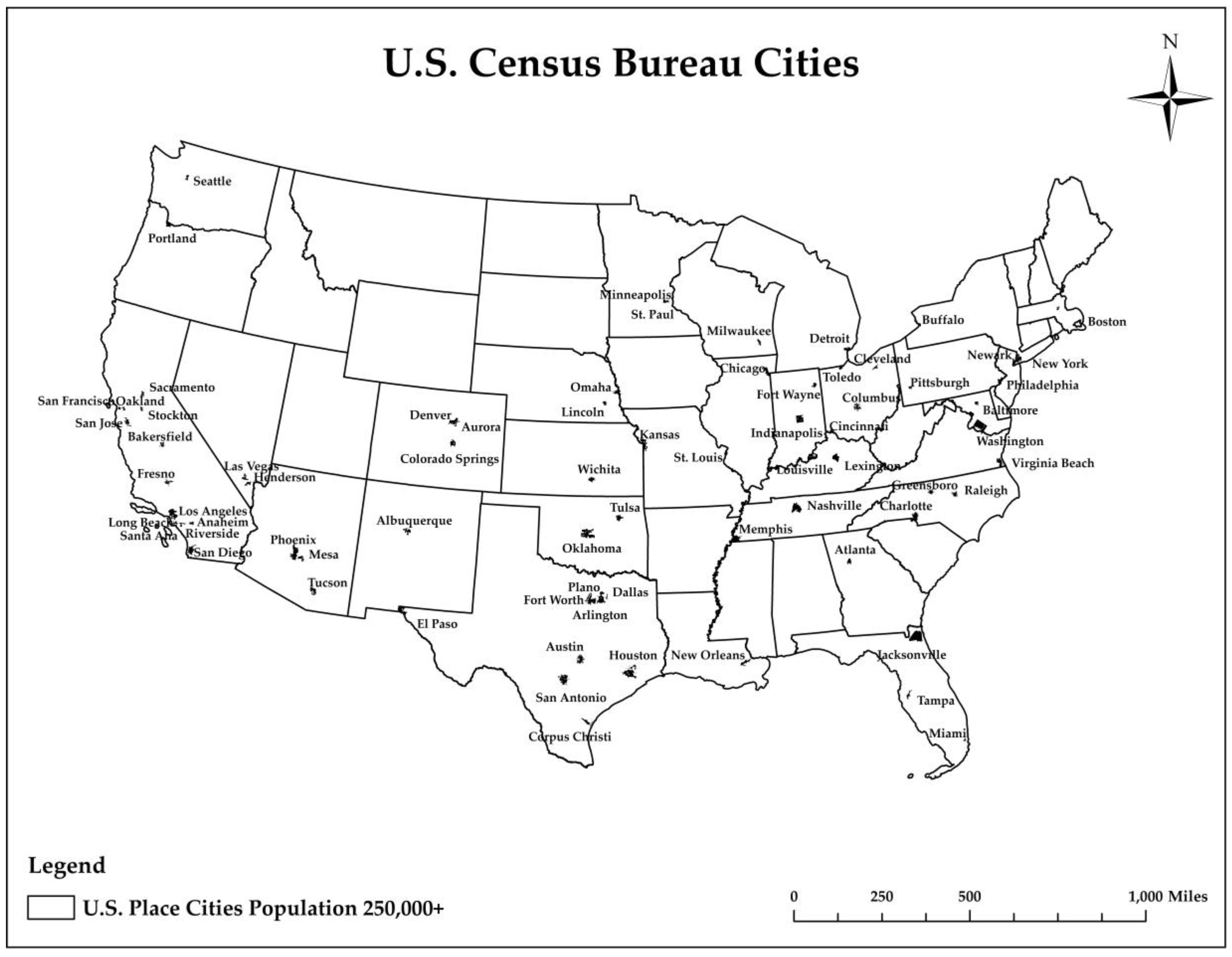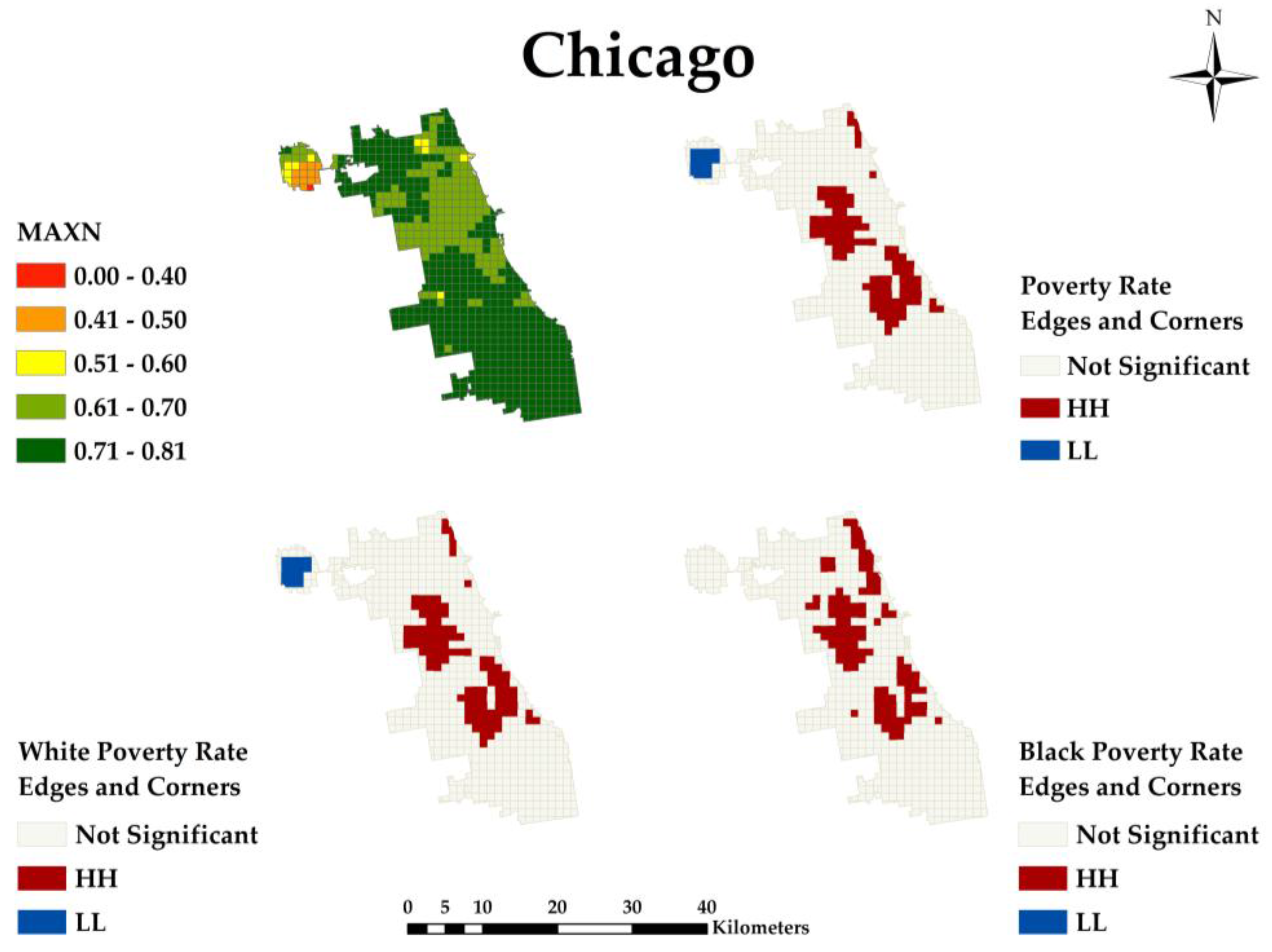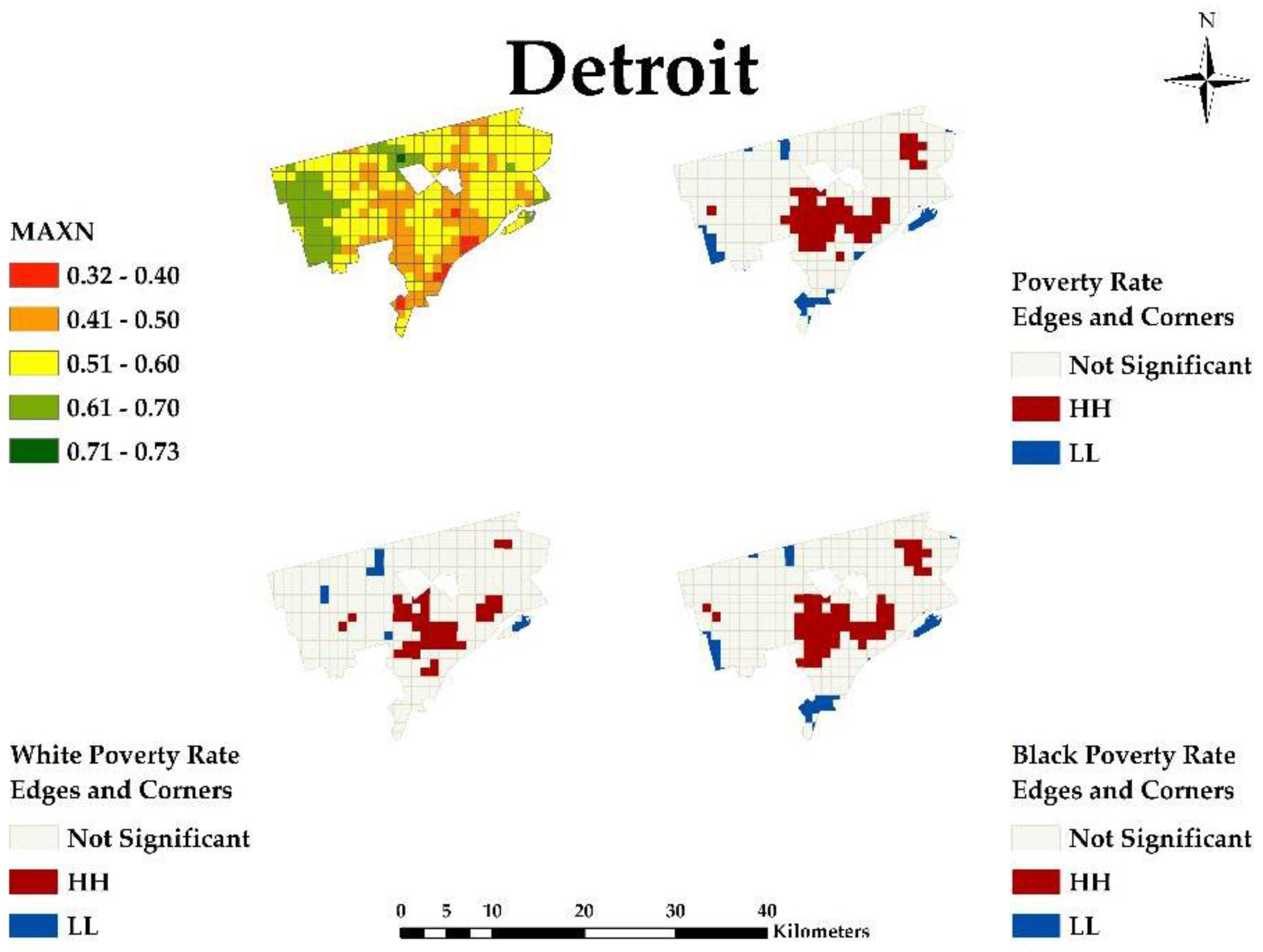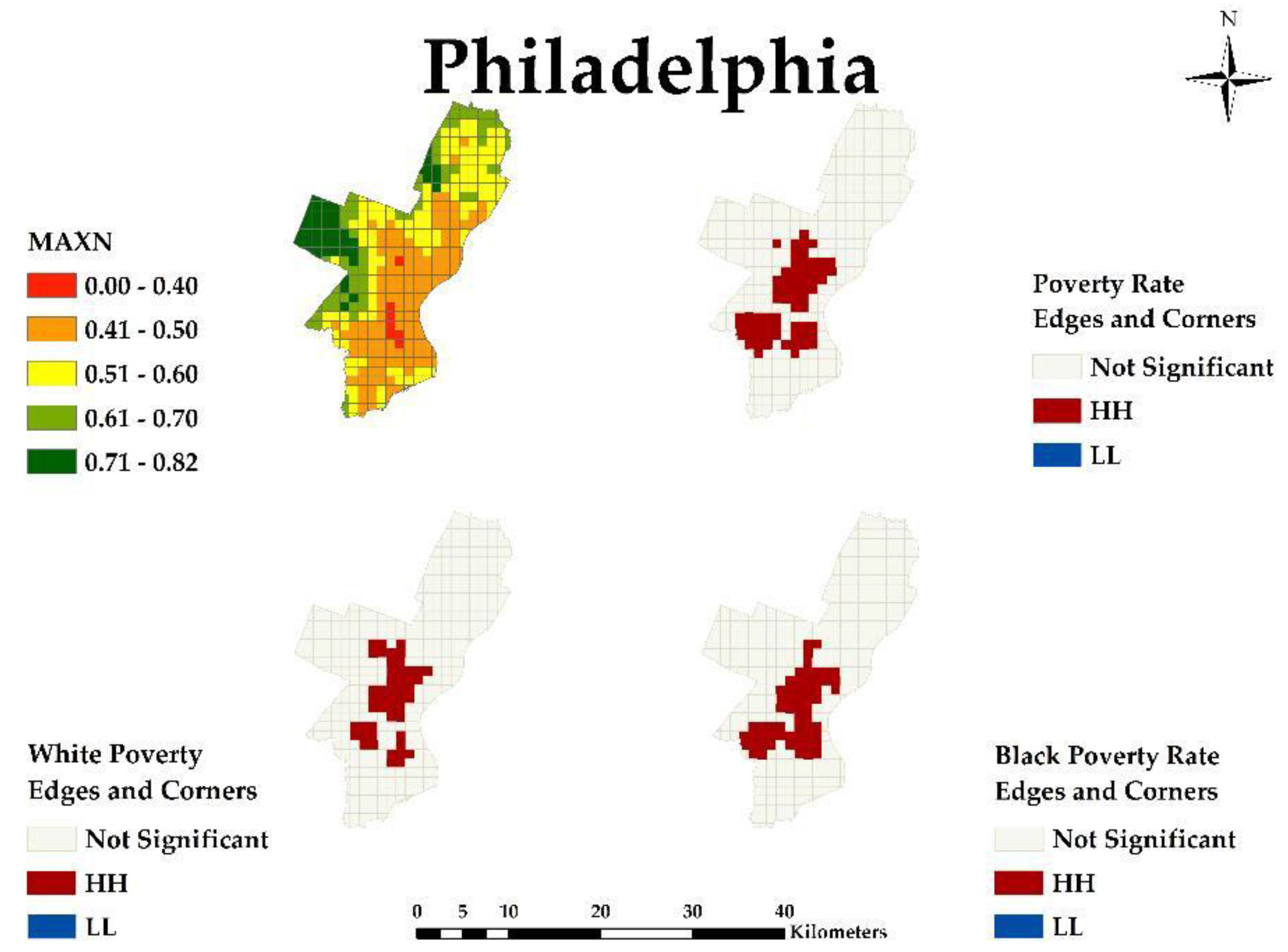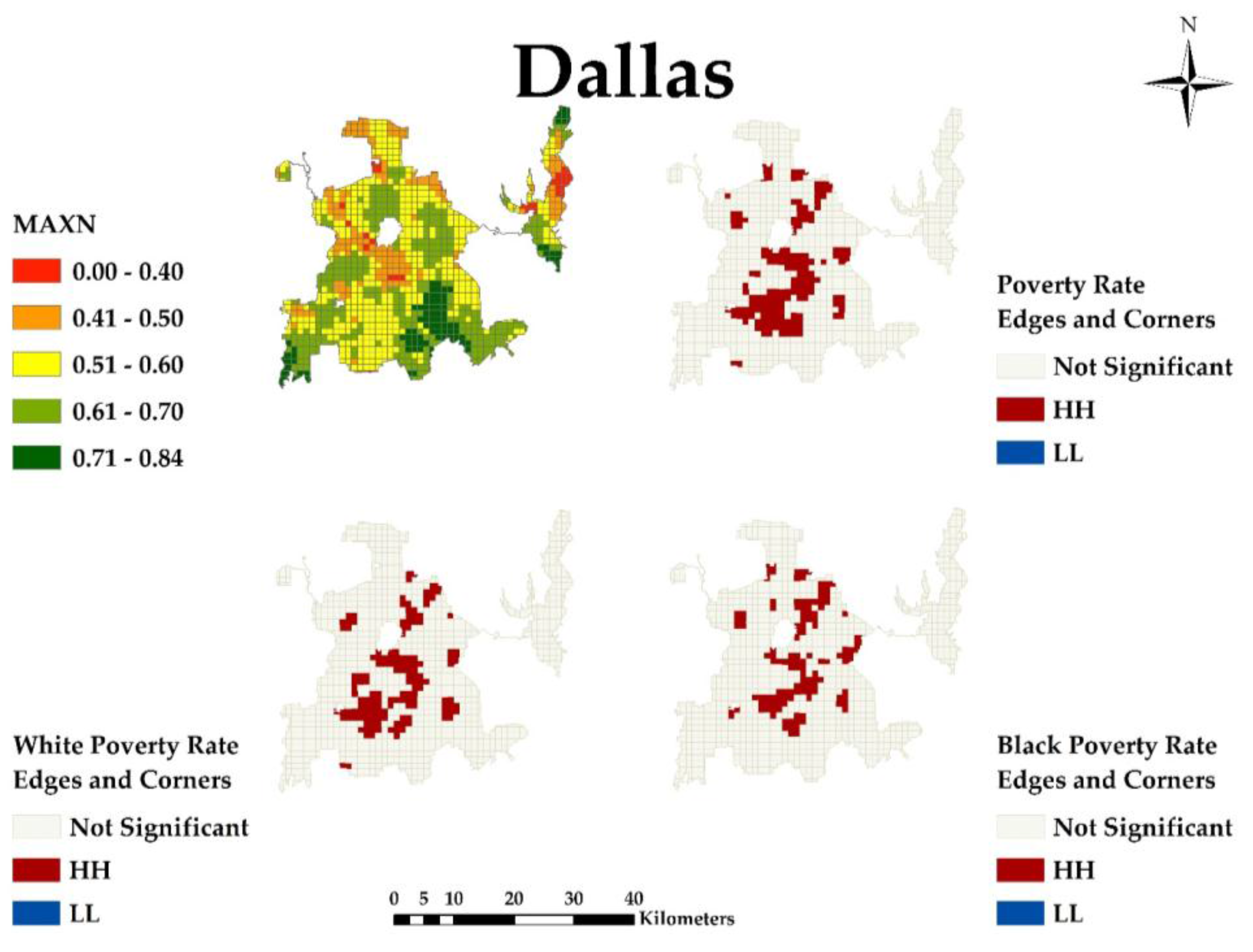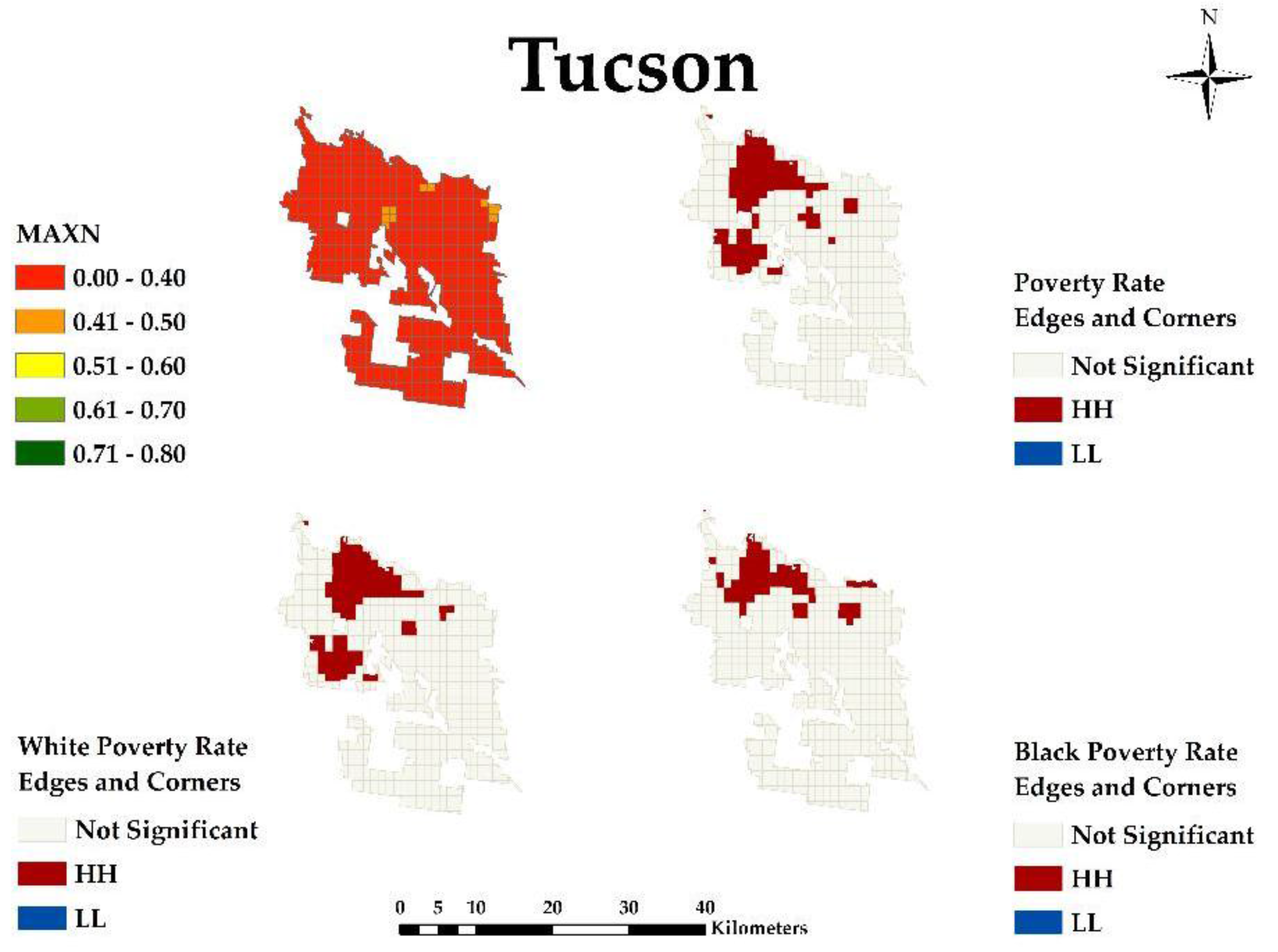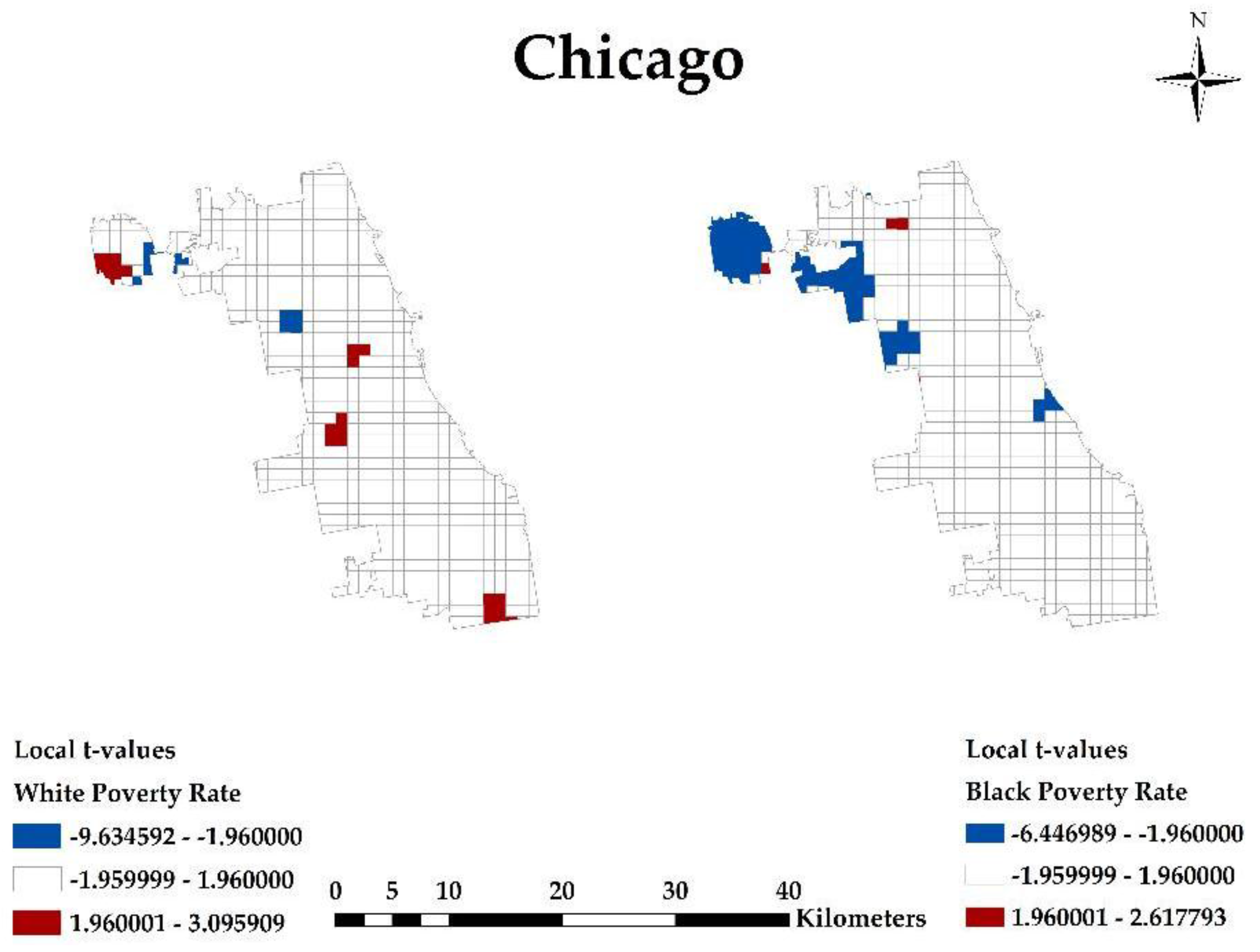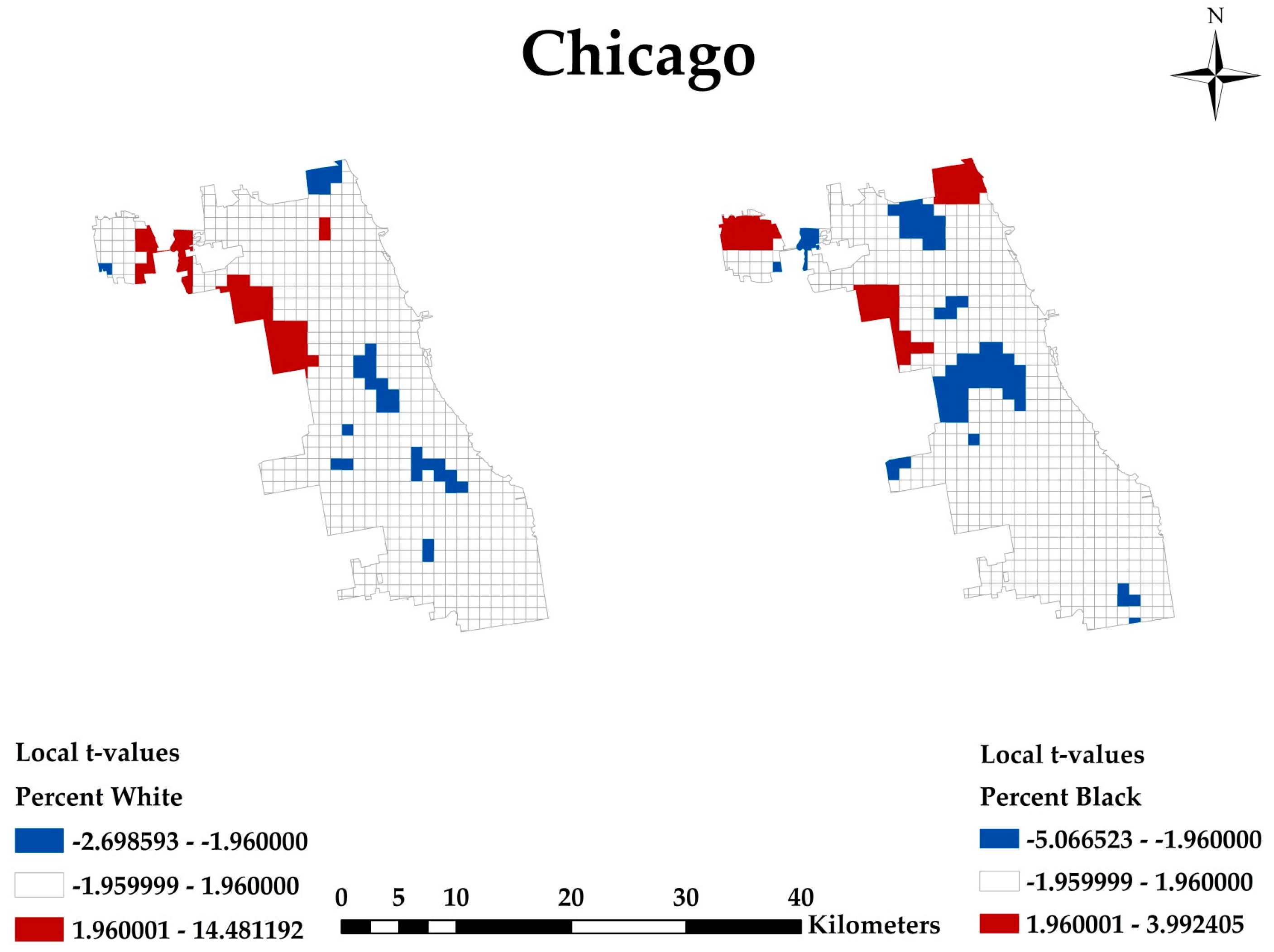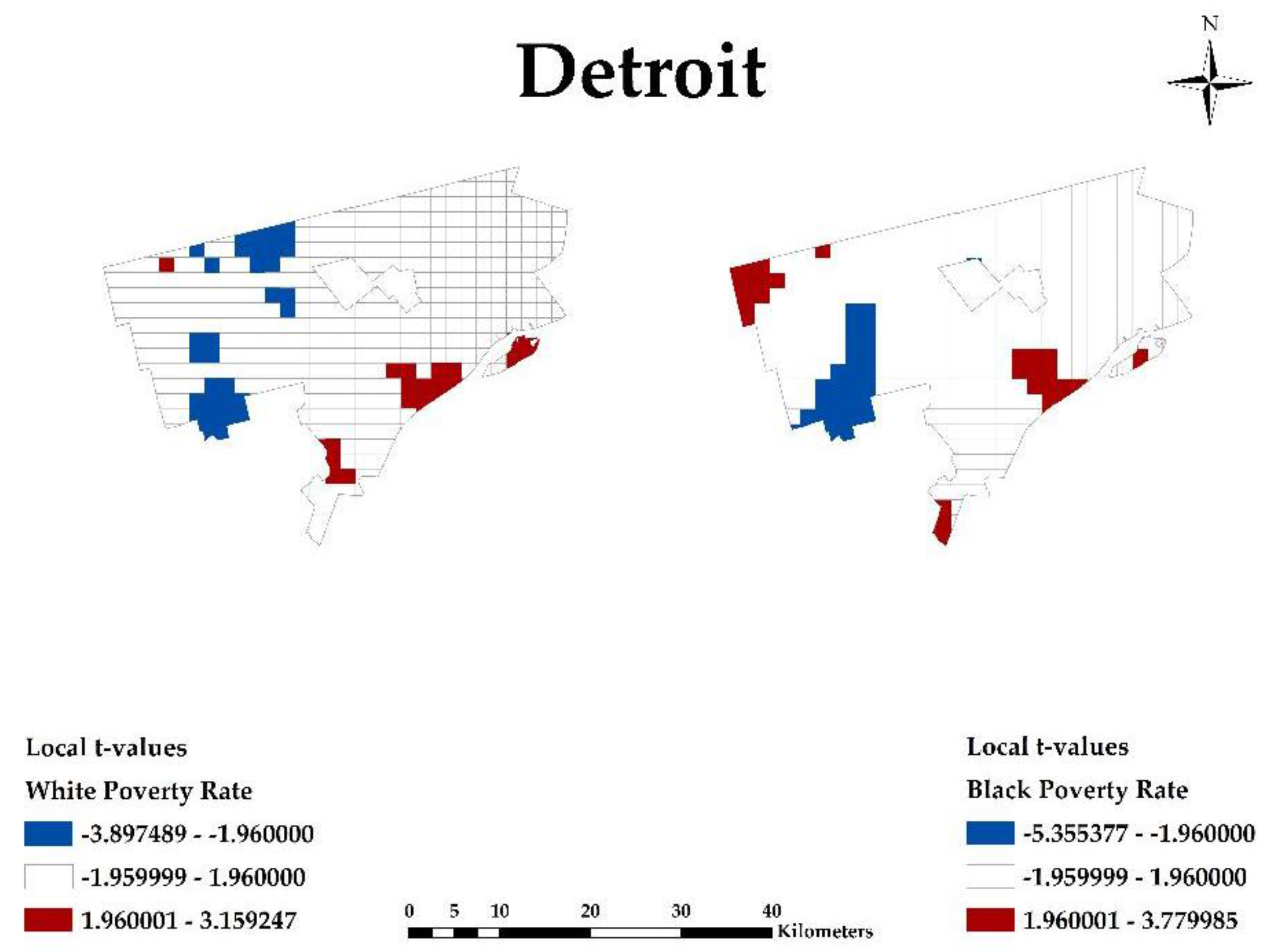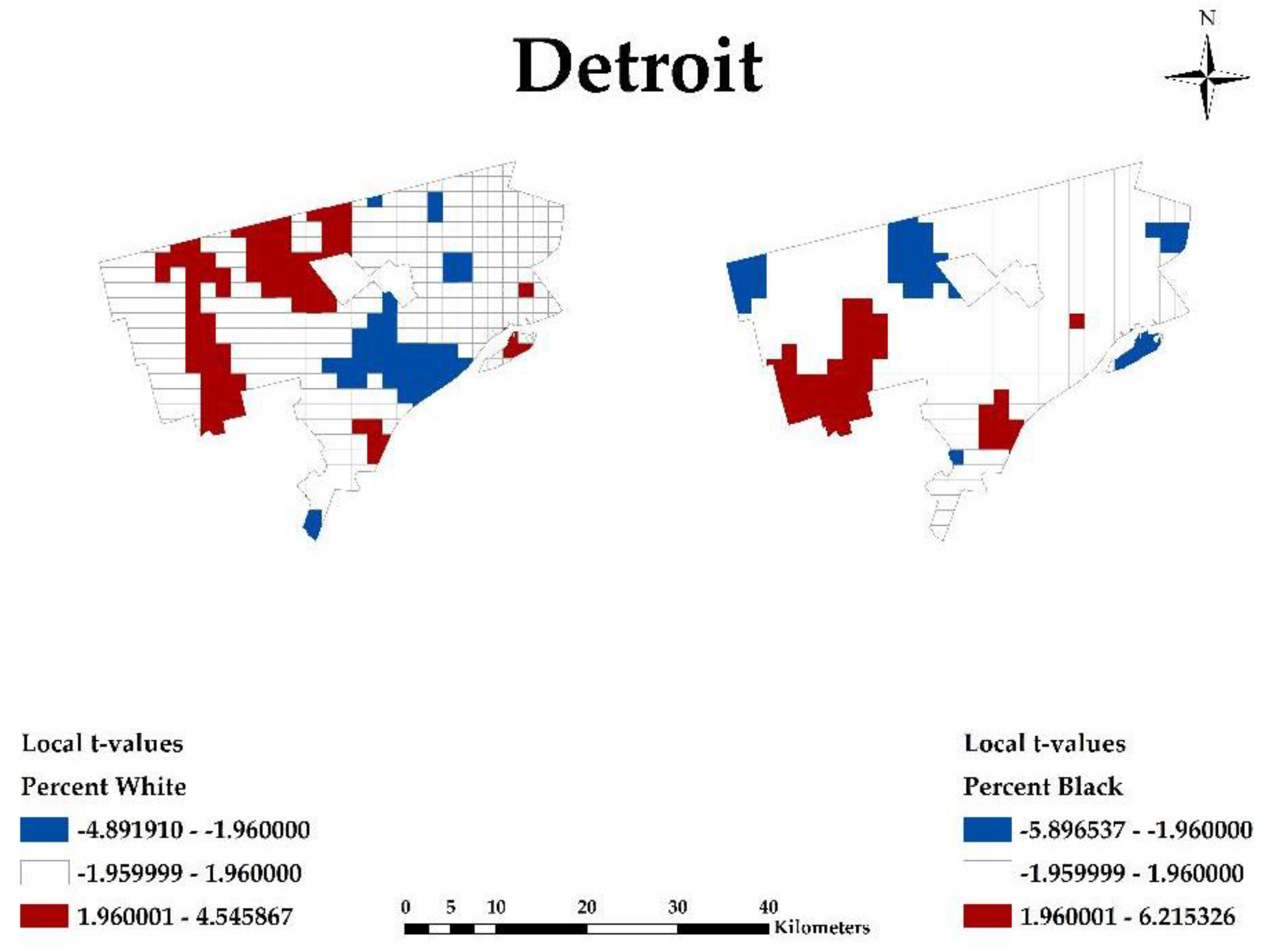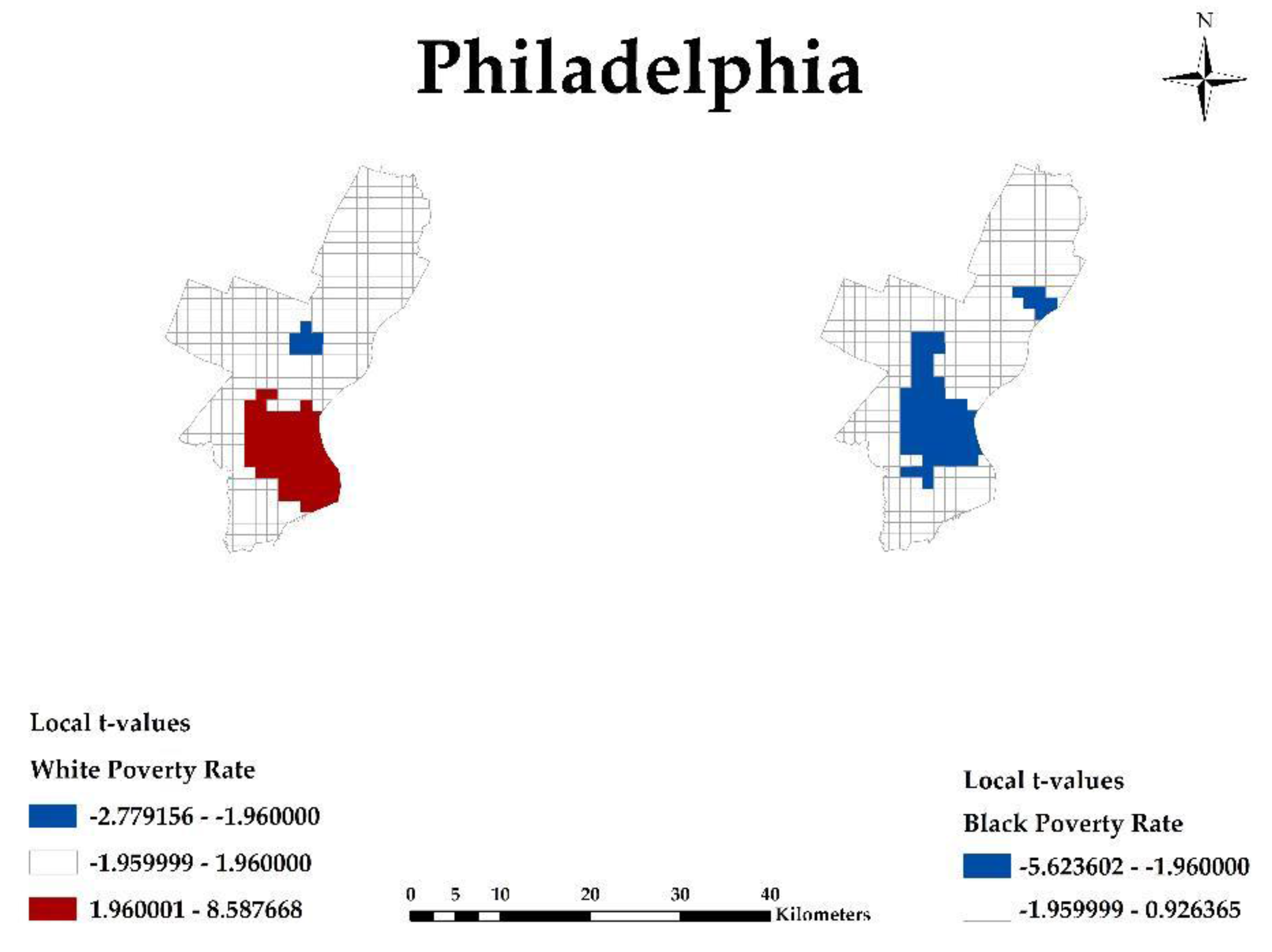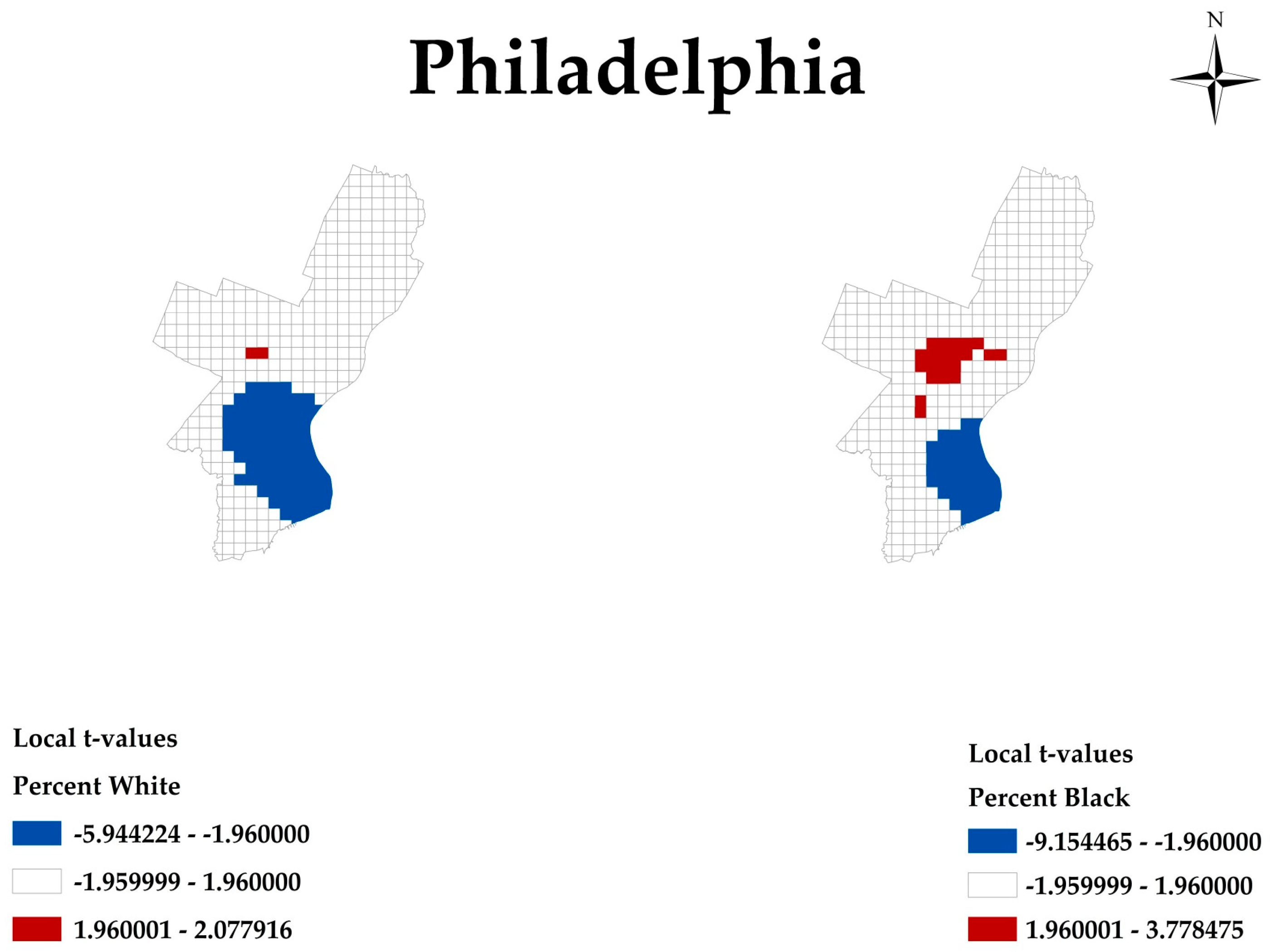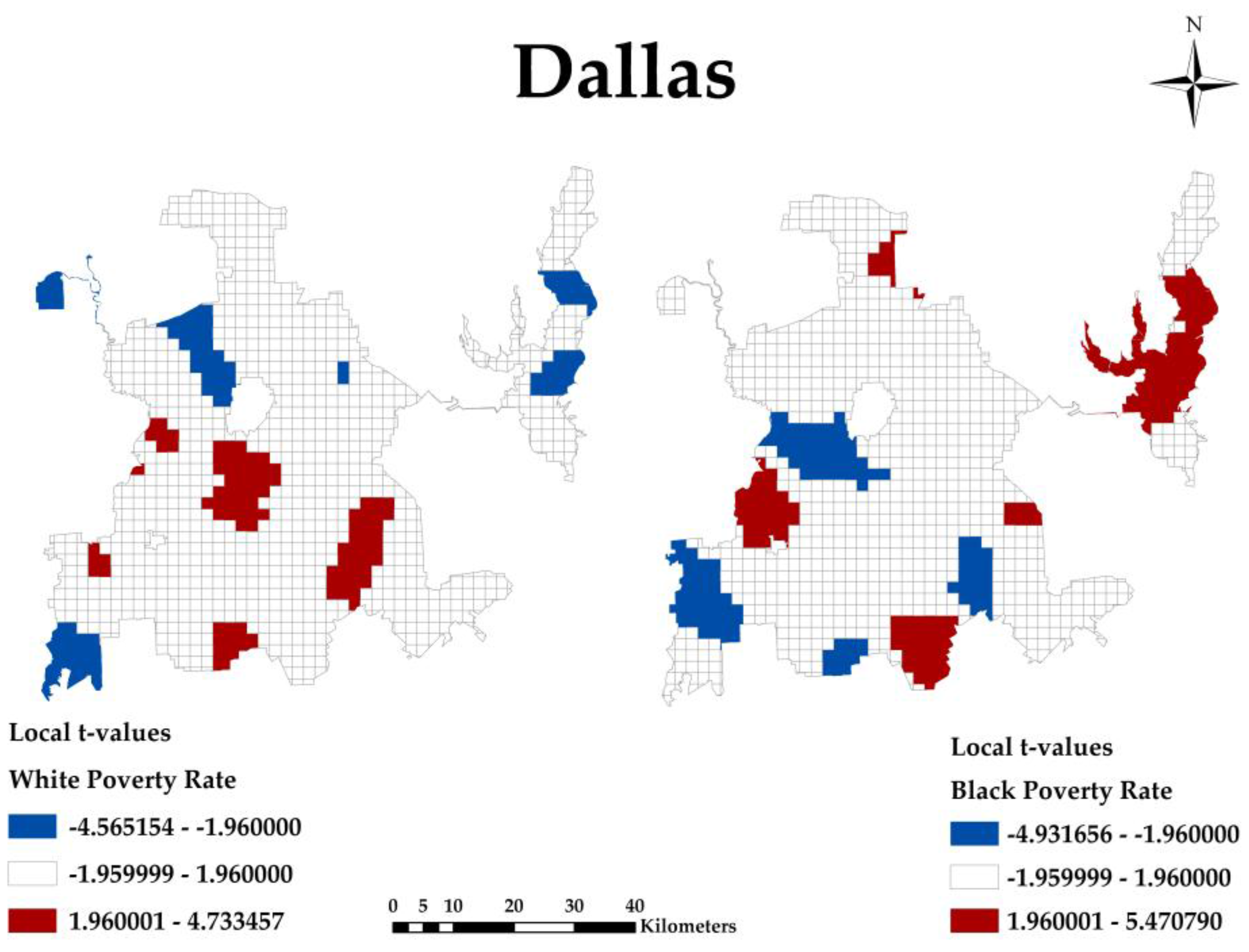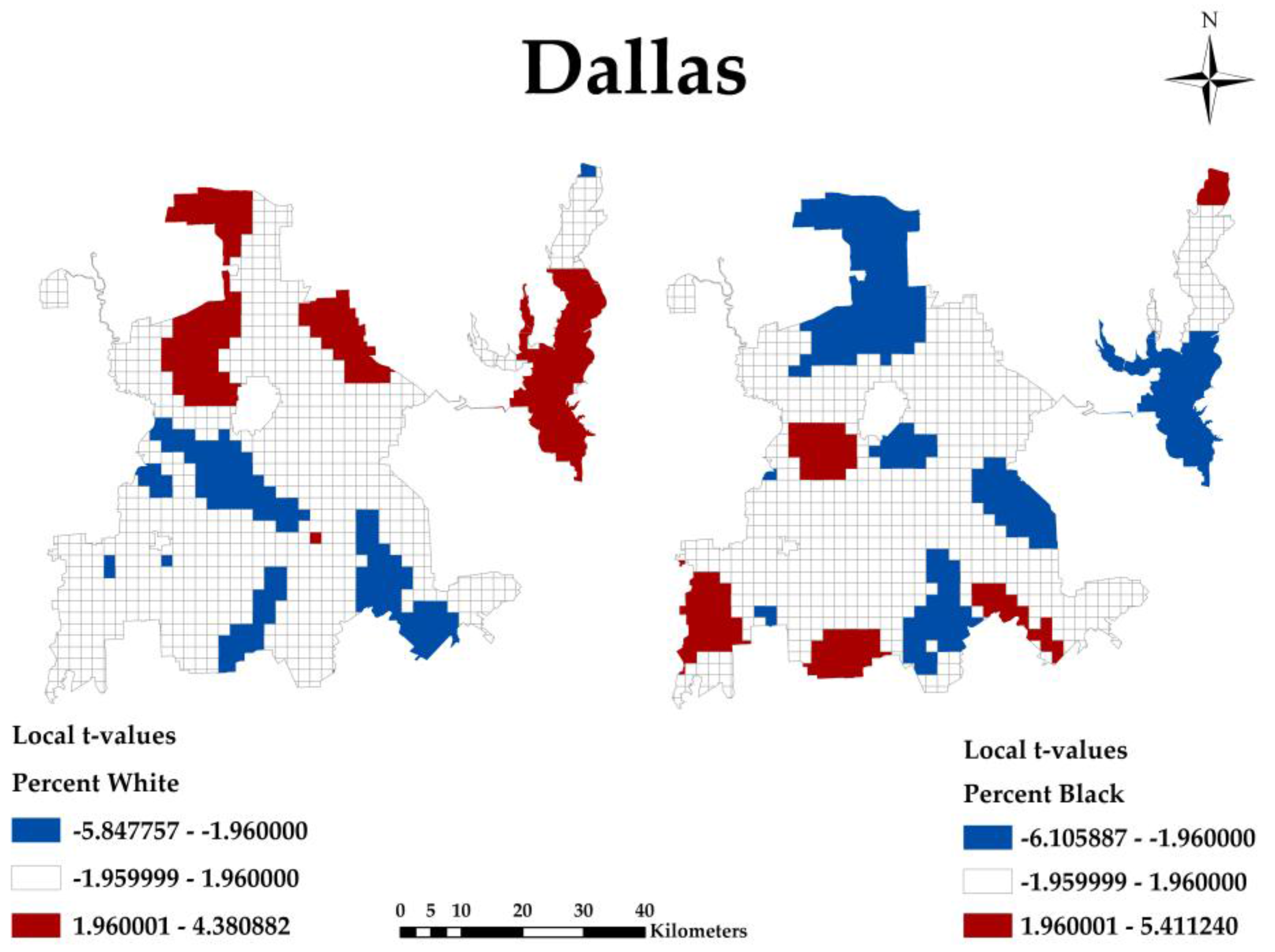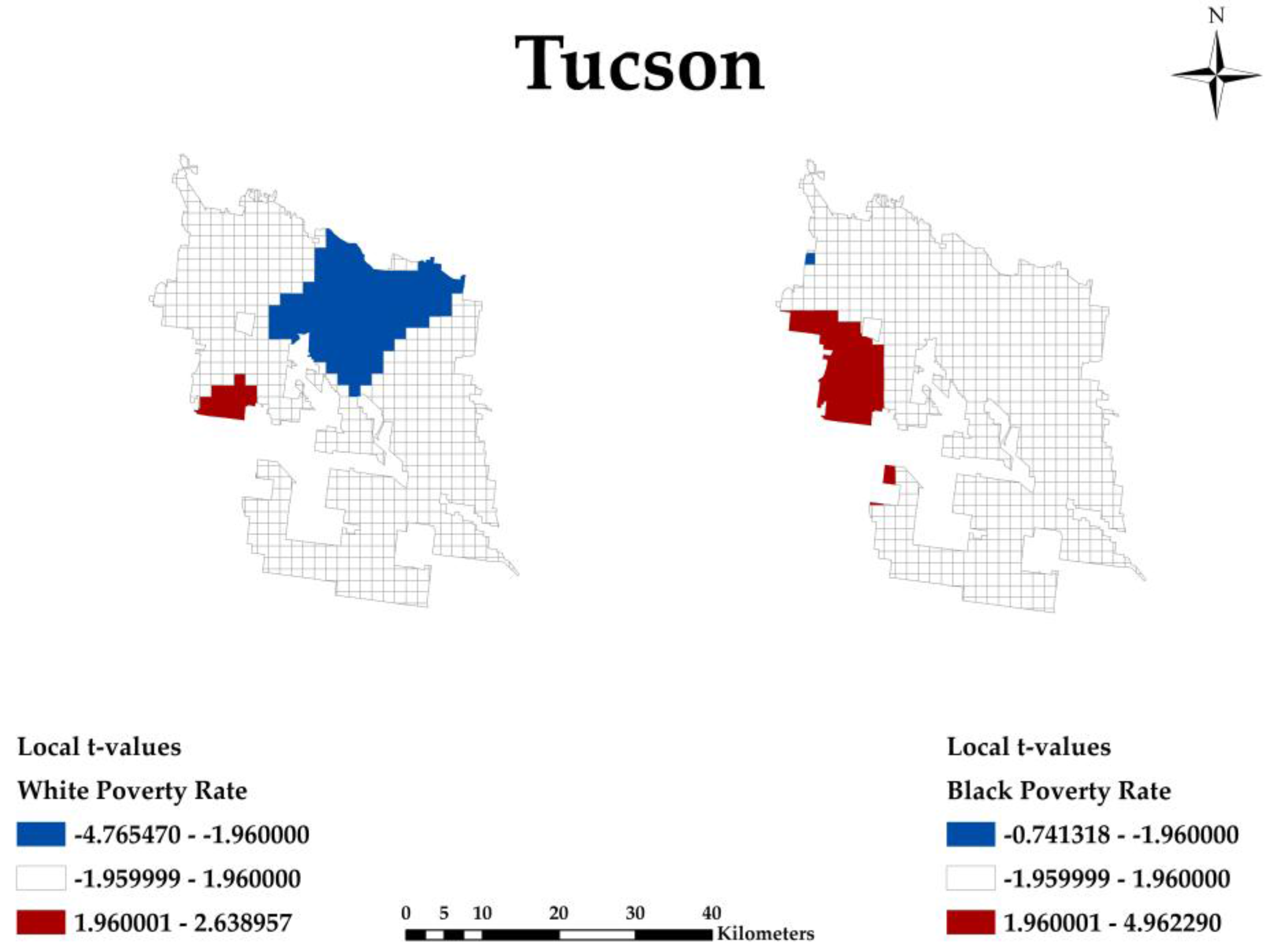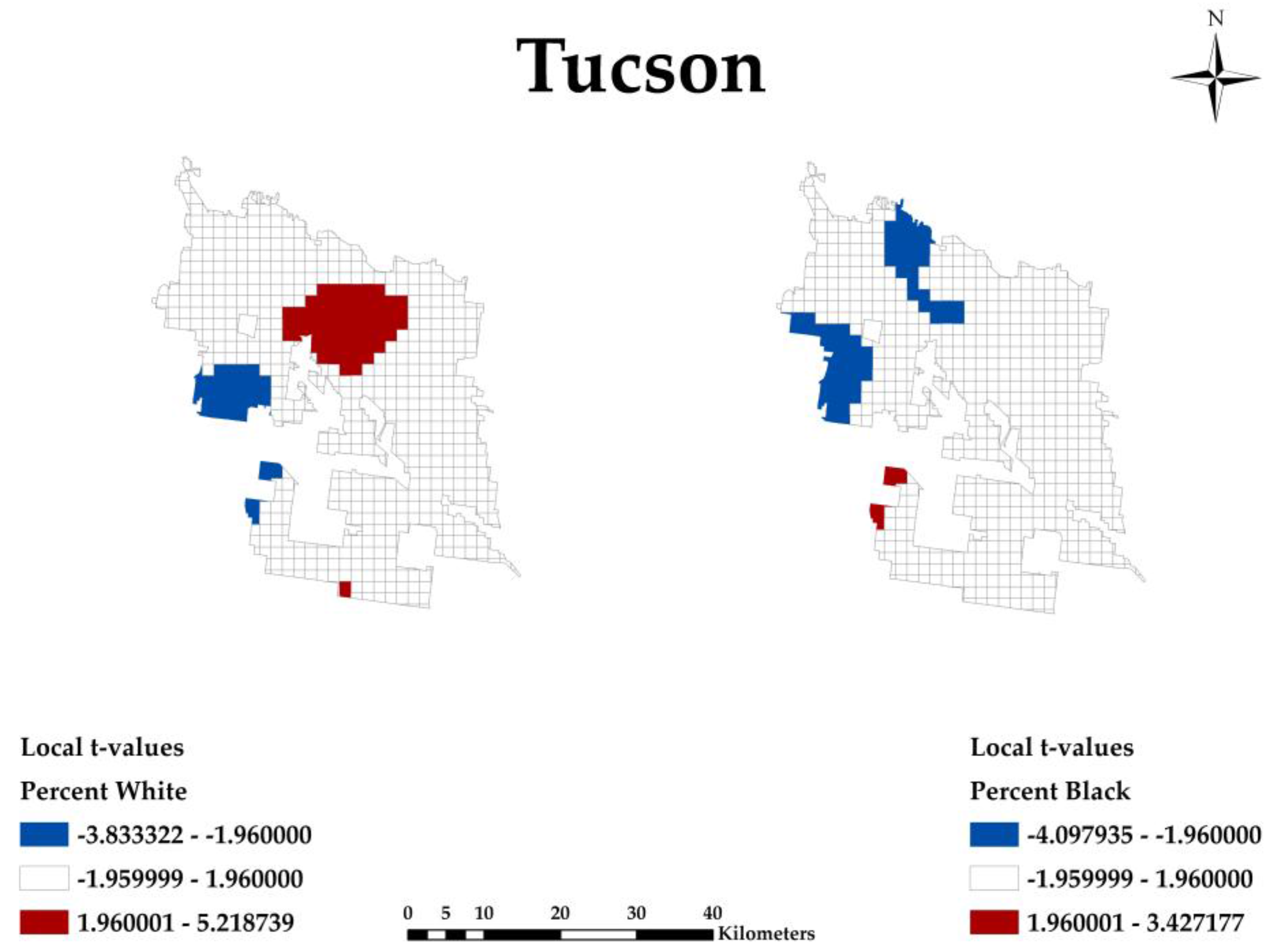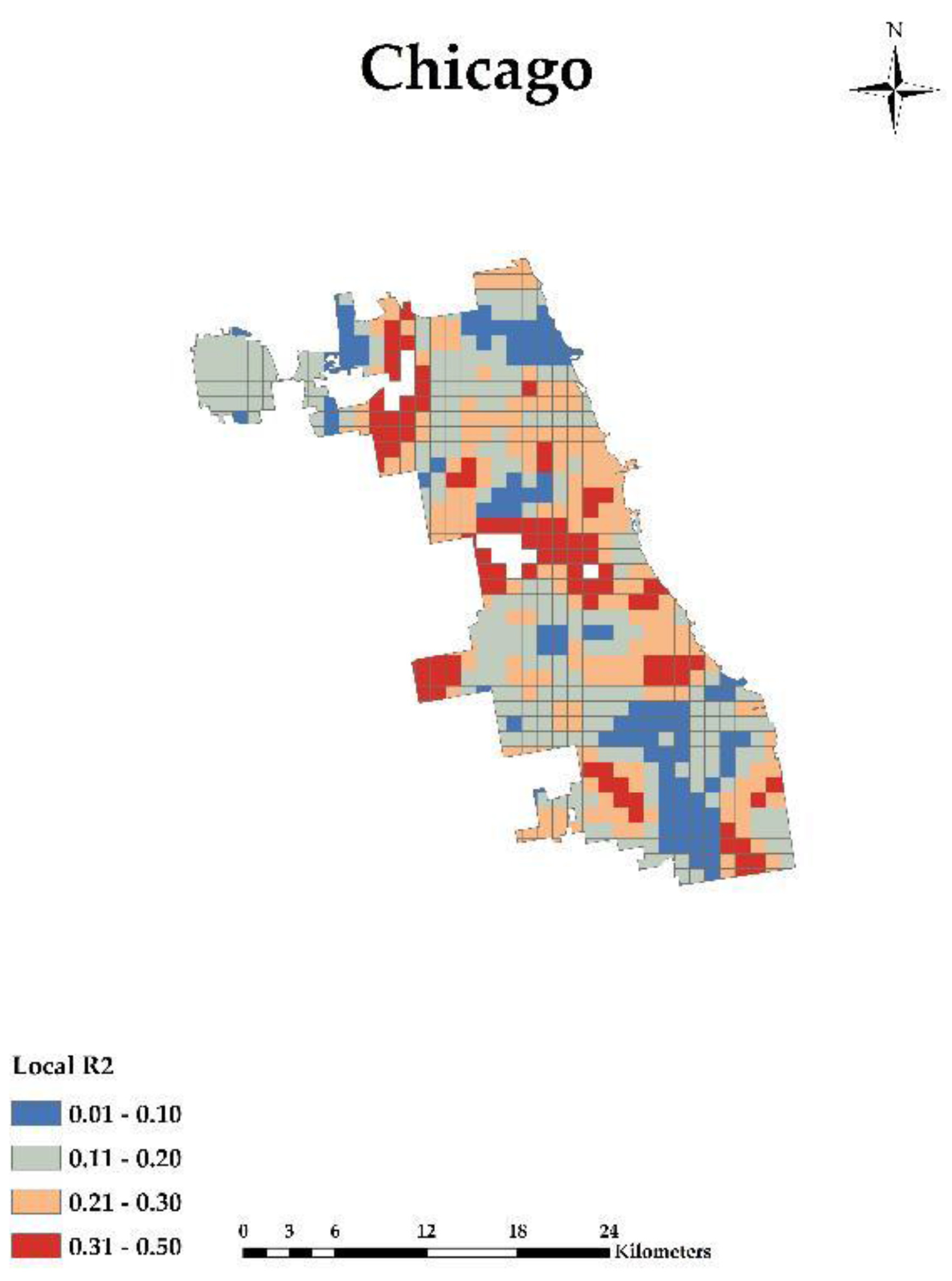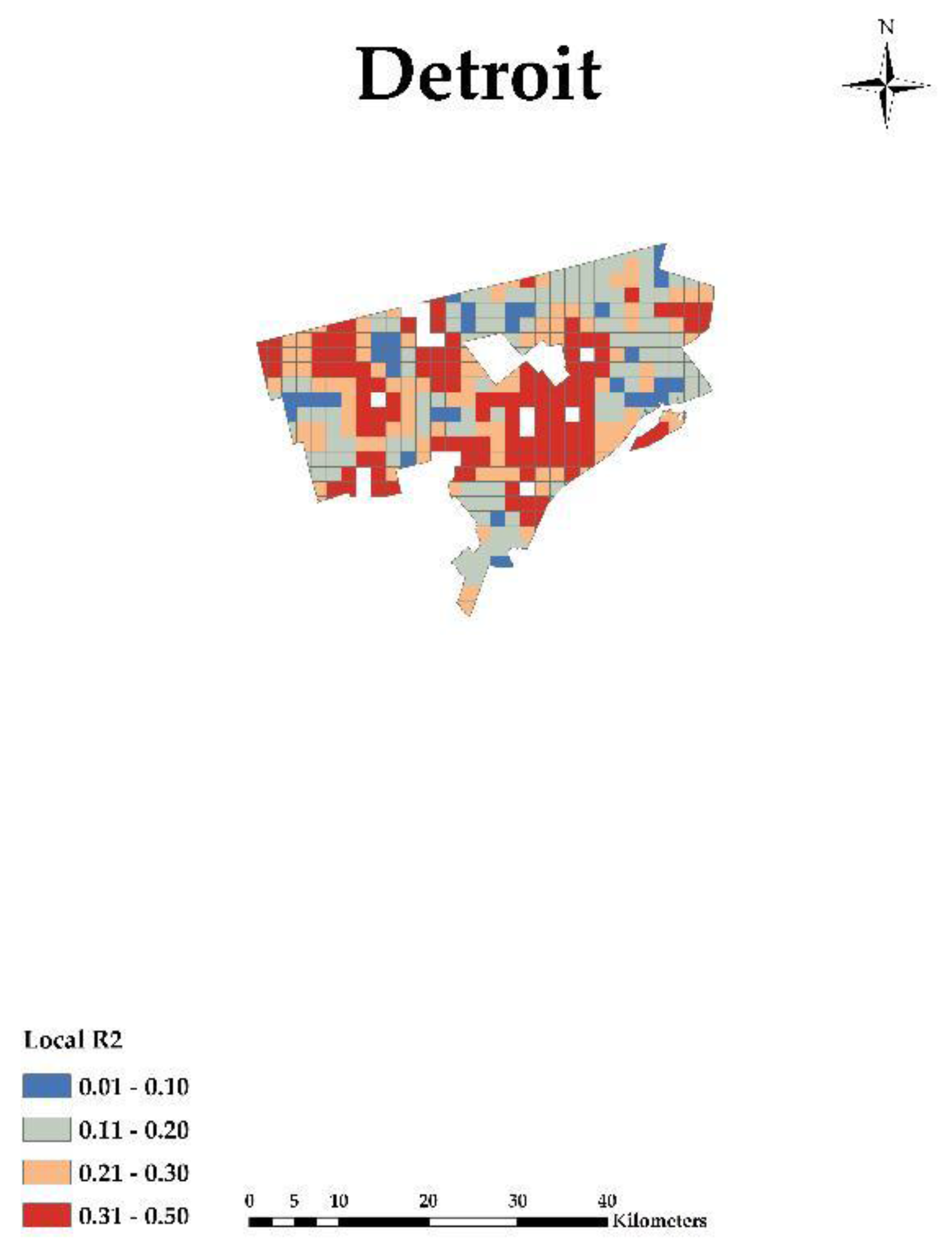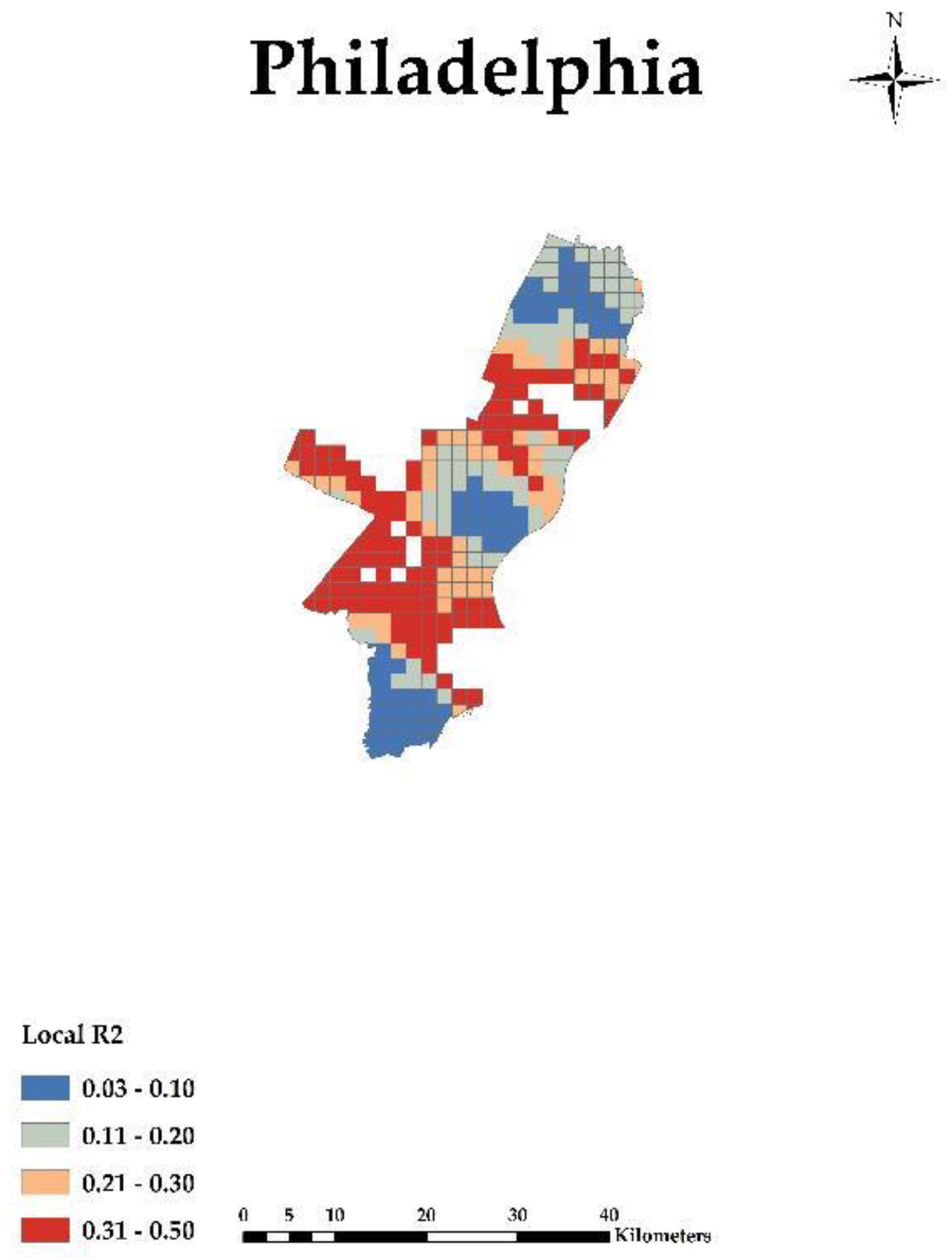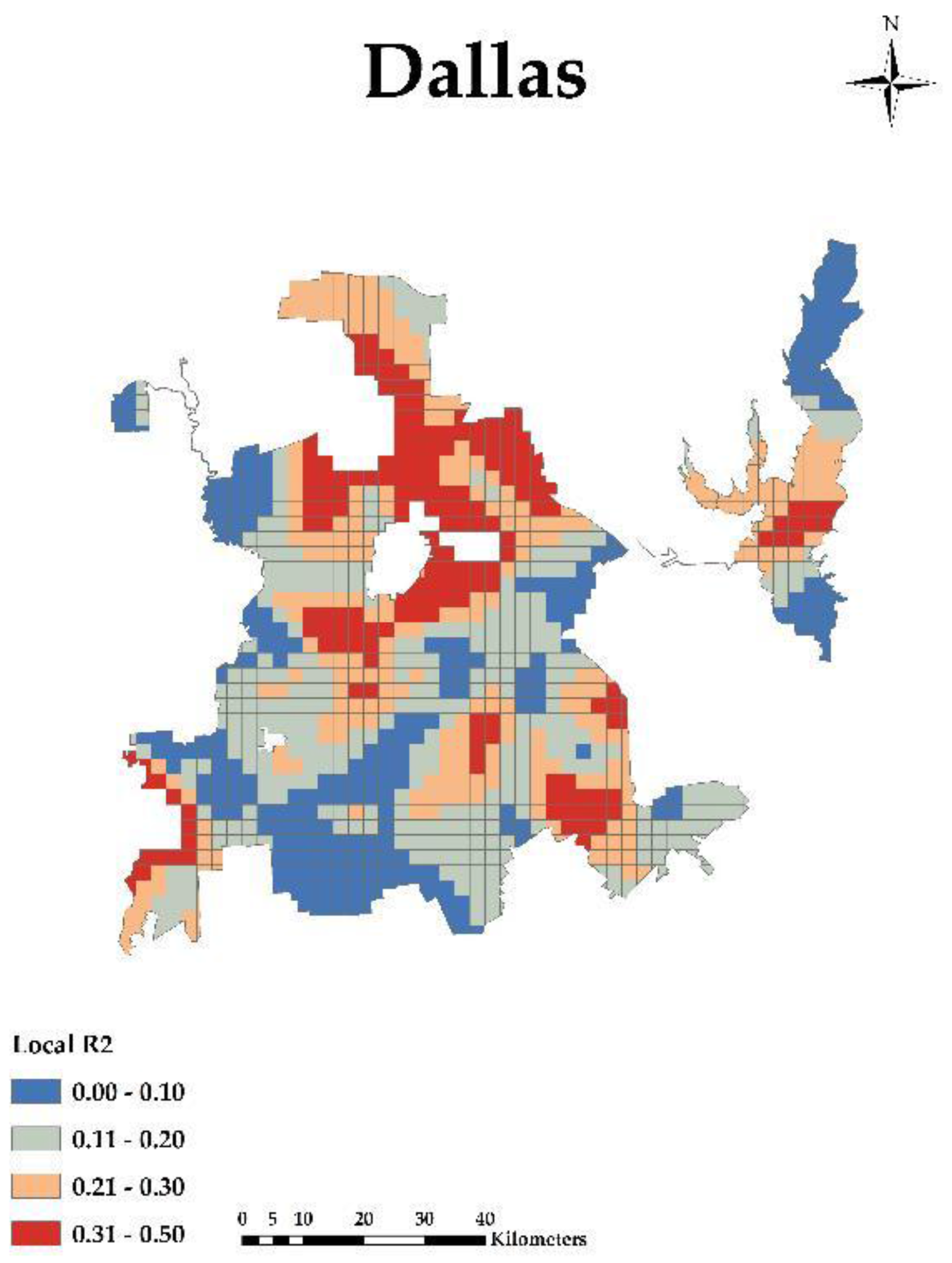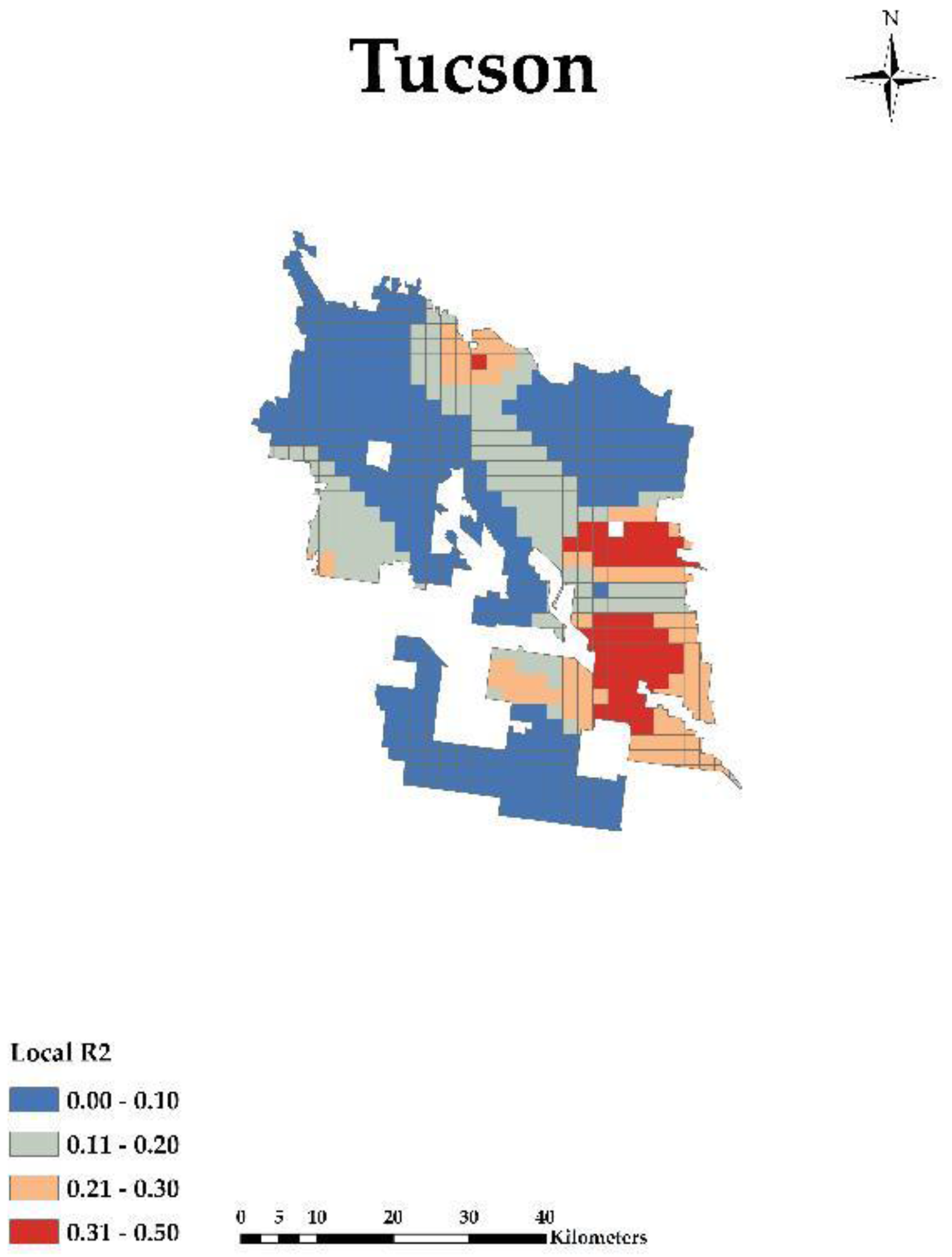Figure 1.
72 United States (U.S.) cities that have a population greater than or equal to 250,000 in 2010.
Figure 1.
72 United States (U.S.) cities that have a population greater than or equal to 250,000 in 2010.
Figure 2.
The Local Indicators of Spatial Association (LISA) maps of Chicago shrinking city: MAXN, Poverty Rate, White Poverty Rate, and Black Poverty Rate.
Figure 2.
The Local Indicators of Spatial Association (LISA) maps of Chicago shrinking city: MAXN, Poverty Rate, White Poverty Rate, and Black Poverty Rate.
Figure 3.
The LISA maps of Detroit shrinking city: MAXN, Poverty Rate, White Poverty Rate, and Black Poverty Rate.
Figure 3.
The LISA maps of Detroit shrinking city: MAXN, Poverty Rate, White Poverty Rate, and Black Poverty Rate.
Figure 4.
The LISA maps of Philadelphia shrinking city: MAXN, Poverty Rate, White Poverty Rate, and Black Poverty Rate.
Figure 4.
The LISA maps of Philadelphia shrinking city: MAXN, Poverty Rate, White Poverty Rate, and Black Poverty Rate.
Figure 5.
The LISA maps of Dallas growing city: MAXN, Poverty Rate, White Poverty Rate, and Black Poverty Rate.
Figure 5.
The LISA maps of Dallas growing city: MAXN, Poverty Rate, White Poverty Rate, and Black Poverty Rate.
Figure 6.
The LISA maps of Tucson growing city: MAXN, Poverty Rate, White Poverty Rate, and Black Poverty Rate.
Figure 6.
The LISA maps of Tucson growing city: MAXN, Poverty Rate, White Poverty Rate, and Black Poverty Rate.
Figure 7.
Chicago shrinking city White Poverty Rate and Black Poverty Rate: 95% two-tailed test (−1.96:1.96).
Figure 7.
Chicago shrinking city White Poverty Rate and Black Poverty Rate: 95% two-tailed test (−1.96:1.96).
Figure 8.
Chicago shrinking city Percent White and Percent Black: 95% two-tailed test (−1.96:1.96).
Figure 8.
Chicago shrinking city Percent White and Percent Black: 95% two-tailed test (−1.96:1.96).
Figure 9.
Detroit shrinking city White Poverty Rate and Black Poverty Rate: 95% two-tailed test (−1.96:1.96).
Figure 9.
Detroit shrinking city White Poverty Rate and Black Poverty Rate: 95% two-tailed test (−1.96:1.96).
Figure 10.
Chicago shrinking city Percent White and Percent Black: 95% two-tailed test (−1.96:1.96).
Figure 10.
Chicago shrinking city Percent White and Percent Black: 95% two-tailed test (−1.96:1.96).
Figure 11.
Philadelphia shrinking city White Poverty Rate and Black Poverty Rate: 95% two-tailed test (−1.96:1.96).
Figure 11.
Philadelphia shrinking city White Poverty Rate and Black Poverty Rate: 95% two-tailed test (−1.96:1.96).
Figure 12.
Philadelphia shrinking city Percent White and Percent Black: 95% two-tailed test (−1.96:1.96) for 2010.
Figure 12.
Philadelphia shrinking city Percent White and Percent Black: 95% two-tailed test (−1.96:1.96) for 2010.
Figure 13.
Dallas growing city White Poverty Rate and Black Poverty Rate: 95% two-tailed test (−1.96:1.96).
Figure 13.
Dallas growing city White Poverty Rate and Black Poverty Rate: 95% two-tailed test (−1.96:1.96).
Figure 14.
Dallas growing city Percent White and Percent Black: 95% two-tailed test (−1.96:1.96).
Figure 14.
Dallas growing city Percent White and Percent Black: 95% two-tailed test (−1.96:1.96).
Figure 15.
Tucson growing city White Poverty Rate and Black Poverty Rate: 95% two-tailed test (−1.96:1.96).
Figure 15.
Tucson growing city White Poverty Rate and Black Poverty Rate: 95% two-tailed test (−1.96:1.96).
Figure 16.
Tucson growing city Percent White and Percent Black: 95% two-tailed test (−1.96:1.96).
Figure 16.
Tucson growing city Percent White and Percent Black: 95% two-tailed test (−1.96:1.96).
Figure 17.
Chicago shrinking city: GWR Local r-squared.
Figure 17.
Chicago shrinking city: GWR Local r-squared.
Figure 18.
Detroit shrinking city: GWR Local r-squared.
Figure 18.
Detroit shrinking city: GWR Local r-squared.
Figure 19.
Philadelphia shrinking city: GWR Local r-squared.
Figure 19.
Philadelphia shrinking city: GWR Local r-squared.
Figure 20.
Dallas growing city: GWR Local r-squared.
Figure 20.
Dallas growing city: GWR Local r-squared.
Figure 21.
Tucson growing city: GWR Local r-squared.
Figure 21.
Tucson growing city: GWR Local r-squared.
Table 1.
Descriptive Variables and Definitions.
Table 1.
Descriptive Variables and Definitions.
| Variables | Description |
|---|
| Dependent |
| NDVI | The Normalized Difference Vegetation Index (NDVI) is an index of plant “greenness” or photosynthetic activity, and is one of the most commonly used vegetation indices. Vegetation indices are based on the observation that different surfaces reflect different types of light differently. Photosynthetically active vegetation, in particular, absorbs most of the red light that hits it while reflecting much of the near infrared light. Vegetation that is dead or stressed reflects more red light and less near infrared light. Likewise, non-vegetated surfaces have a much more even reflectance across the light spectrum. |
| MAXN | The highest (or peak) value in NDVI observed (clear and not contaminated by cloud or cloud shadows) in a growing season (unit less based on NDVI units). |
| Independent |
| Poverty | Living in a household with a total cash income below 50 percent of its poverty threshold. |
| White Poverty | Percent White Alone Population for whom poverty status is determined. |
| Black Poverty | Percent Black or African American Alone Population for whom poverty status is determined. |
| White Population | Percent White Alone Population for whom poverty status is determined. |
| Black Population | Percent Black or African American Alone Population for whom poverty status is determined. |
Table 2.
Regression relations of time series 16 year Maximum Normalized Difference Vegetation Index, MAXN Delta (regression coefficient for the time variable showing trend in NDVI), and descriptive statistics of r-squared for 14 Shrinking Cities. We selected three cities Chicago, Detroit, and Philadelphia that were one standard deviation above the overall r-squared mean and one standard deviation below the overall r-squared mean, to show cities that were different from the typical cities. The cities had a low, typical, and high, 16-year series r-squared mean.
Table 2.
Regression relations of time series 16 year Maximum Normalized Difference Vegetation Index, MAXN Delta (regression coefficient for the time variable showing trend in NDVI), and descriptive statistics of r-squared for 14 Shrinking Cities. We selected three cities Chicago, Detroit, and Philadelphia that were one standard deviation above the overall r-squared mean and one standard deviation below the overall r-squared mean, to show cities that were different from the typical cities. The cities had a low, typical, and high, 16-year series r-squared mean.
| Cities | 1990 Pop | 2010 Pop | Pop Change | 16 Year Series MAXN Mean | MAXN Delta (2010–1990) | r-Squared Mean |
|---|
| Detroit, MI | 1,027,974 | 713,777 | −314,197 | 171.6875 | 7 | 0.4019 |
| Cincinnati, OH | 364,040 | 296,943 | −67,097 | 182.625 | 4 | 0.3731 |
| Toledo, OH | 332,943 | 287,208 | −45,735 | 174.1875 | 5 | 0.3718 |
| Milwaukee, WI | 628,088 | 594,833 | −33,255 | 174.5625 | 11 | 0.3701 |
| St. Louis City, MO | 396,685 | 319,294 | −77,391 | 169.1875 | 7 | 0.3181 |
| Baltimore, MD | 736,014 | 620,961 | −115,053 | 180.6875 | 11 | 0.3143 |
| Pittsburgh, PA | 369,897 | 305,704 | −64,193 | 179.0625 | 5 | 0.2668 |
| Washington, DC | 606,900 | 601,723 | −5177 | 183.125 | 4 | 0.2564 |
| Cleveland, OH | 505,616 | 396,815 | −108,801 | 174.25 | −2 | 0.2516 |
| Philadelphia, PA | 1,585,577 | 1,526,006 | −59,571 | 182.4375 | 4 | 0.2397 |
| Chicago, IL | 2,783,726 | 2,695,598 | −88,128 | 175 | 12 | 0.2139 |
| Oakland, CA | 505,616 | 390,724 | −114,892 | 173.6875 | 2 | 0.2042 |
| Buffalo, NY | 328,123 | 261,310 | −66,813 | 167.9375 | 5 | 0.1962 |
| New Orleans, LA | 496,938 | 343,829 | −153,109 | 184.0625 | 9 | 0.1309 |
Table 3.
Regression relations of time series 16 year MAXN, MAXN Delta (regression coefficient for the time variable showing trend in NDVI), and descriptive statistics of r-squared for 58 Growing Cities. We selected two cities Dallas and Tucson that were one standard deviation above the overall r-squared mean and one standard deviation below the overall r-squared mean, to show cities that were different from the typical cities. The cities had a low, typical, and high, 16-year series r-squared mean.
Table 3.
Regression relations of time series 16 year MAXN, MAXN Delta (regression coefficient for the time variable showing trend in NDVI), and descriptive statistics of r-squared for 58 Growing Cities. We selected two cities Dallas and Tucson that were one standard deviation above the overall r-squared mean and one standard deviation below the overall r-squared mean, to show cities that were different from the typical cities. The cities had a low, typical, and high, 16-year series r-squared mean.
| Cities | 1990 Pop | 2010 Pop | Pop Change | 16 Year Series MAXN Mean | MAXN Delta (2010–1990) | r-Squared Mean |
|---|
| Lexington, KY | 225,366 | 295,803 | 70,437 | 183.8125 | 5 | 0.4275 |
| Indianapolis, IN | 731,327 | 820,445 | 89,118 | 183.4375 | 6 | 0.3954 |
| Nashville, TN | 510,784 | 601,222 | 90,438 | 188 | 3 | 0.3845 |
| Kansas City, MO | 435,146 | 459,787 | 24,641 | 184.1875 | 6 | 0.3788 |
| Portland, OR | 437,319 | 583,776 | 146,457 | 188.4375 | 7 | 0.3742 |
| St. Paul, MN | 272,235 | 285,068 | 12,833 | 173.5 | 10 | 0.3720 |
| Wichita, KS | 304,011 | 382,368 | 78,357 | 175.875 | 5 | 0.3545 |
| Greensboro, NC | 183,894 | 269,666 | 85,772 | 181.6875 | 3 | 0.3524 |
| Oklahoma City, OK | 444,719 | 579,999 | 135,280 | 178.9375 | 10 | 0.3449 |
| Arlington, TX | 261,721 | 365,438 | 103,717 | 171.8125 | 14 | 0.3409 |
| Louisville, KY | 269,063 | 597,337 | 328,274 | 187.625 | 7 | 0.3395 |
| Memphis, TN | 610,337 | 646,889 | 36,552 | 183.75 | 0 | 0.3258 |
| Jacksonville, FL | 635,230 | 821,784 | 186,554 | 185.8125 | 12 | 0.3257 |
| Omaha, NE | 335,795 | 408,958 | 73,163 | 181.0625 | 7 | 0.3256 |
| Seattle, WA | 516,259 | 608,660 | 92,401 | 172.75 | 13 | 0.3234 |
| Dallas, TX | 1,006,877 | 1,197,816 | 190,939 | 180.75 | 11 | 0.3219 |
| Tulsa, OK | 367,302 | 391,906 | 24,604 | 180.8125 | 5 | 0.3200 |
| Atlanta, GA | 394,017 | 420,003 | 25,986 | 179.6875 | 4 | 0.3114 |
| Raleigh, NC | 212,092 | 403,892 | 191,800 | 185 | 3 | 0.3103 |
| Charlotte, NC | 395,934 | 731,424 | 335,490 | 182.4375 | 3 | 0.3056 |
| Virginia Beach, VA | 393,069 | 437,994 | 44,925 | 183.8125 | 3 | 0.3014 |
| Minneapolis, MN | 368,383 | 382,578 | 14,195 | 172.5 | 7 | 0.2997 |
| Fort Wayne, IN | 173,072 | 253,691 | 80,619 | 178.4375 | 5 | 0.2970 |
| Columbus, OH | 632,910 | 787,033 | 154,123 | 182.0625 | 12 | 0.2953 |
| Stockton, CA | 210,943 | 285,068 | 74,125 | 179.1875 | 3 | 0.2951 |
| Sacramento, CA | 369,365 | 466,488 | 97,123 | 176.625 | 12 | 0.2836 |
| Austin, TX | 465,622 | 790,390 | 324,768 | 175.375 | 9 | 0.2470 |
| Fort Worth, TX | 447,619 | 741,206 | 293,587 | 177.625 | 10 | 0.2440 |
| Plano, TX | 128,713 | 259,841 | 131,128 | 167.75 | 4 | 0.2371 |
| Lincoln, NE | 191,972 | 258,379 | 66,407 | 176.6875 | 11 | 0.2353 |
| New York, NY | 7,322,564 | 8,175,133 | 852,569 | 182.5 | 9 | 0.2291 |
| Houston, TX | 1,630,553 | 2,099,451 | 468,898 | 182.625 | 3 | 0.2245 |
| Boston, MA | 574,283 | 617,594 | 43,311 | 178.25 | 1 | 0.2198 |
| Tampa, FL | 280,015 | 335,709 | 55,694 | 181.0625 | 3 | 0.2150 |
| Los Angeles, CA | 3,485,398 | 3,792,621 | 307,223 | 175.0625 | 14 | 0.2058 |
| Fresno, CA | 354,202 | 494,665 | 140,463 | 167.6875 | 9 | 0.2013 |
| San Jose, CA | 782,248 | 945,942 | 163,694 | 179.4375 | 9 | 0.1936 |
| Bakersfield, CA | 174,820 | 347,483 | 172,663 | 175.625 | 4 | 0.1921 |
| Miami, FL | 358,548 | 399,457 | 40,909 | 160.9375 | 4 | 0.1758 |
| Las Vegas, NV | 258,295 | 583,756 | 325,461 | 143.3125 | −1 | 0.1748 |
| Henderson, NV | 64,942 | 257,729 | 192,787 | 141.8125 | 10 | 0.1723 |
| San Antonio, TX | 935,933 | 1,327,407 | 391,474 | 178.1875 | 2 | 0.1694 |
| Albuquerque, NM | 384,736 | 545,852 | 161,116 | 165.0625 | −3 | 0.1610 |
| Long Beach, CA | 429,433 | 462,257 | 32,824 | 153.9375 | 11 | 0.1578 |
| Phoenix, AZ | 983,403 | 1,445,632 | 462,229 | 172.4375 | 5 | 0.1550 |
| Newark, NJ | 275,221 | 277,140 | 1919 | 166.625 | 7 | 0.1518 |
| Corpus Christi, TX | 257,453 | 305,215 | 47,762 | 173.3125 | 8 | 0.1508 |
| San Francisco, CA | 723,959 | 805,235 | 81,276 | 167.5 | 2 | 0.1504 |
| San Diego, CA | 1,110,549 | 1,307,402 | 196,853 | 171.9375 | 10 | 0.1428 |
| Santa Ana, CA | 293,742 | 324,528 | 30,786 | 149.9375 | 10 | 0.1376 |
| Aurora, CO | 222,103 | 325,078 | 102,975 | 169.8125 | 18 | 0.1352 |
| Denver, CO | 467,610 | 600,158 | 132,548 | 166.5625 | 8 | 0.1271 |
| Mesa, AZ | 288,091 | 439,041 | 150,950 | 164.375 | −13 | 0.1249 |
| Tucson, AZ | 405,371 | 520,116 | 114,745 | 150.4375 | −12 | 0.1124 |
| Anaheim, CA | 266,406 | 336,265 | 69,859 | 165 | 9 | 0.0971 |
| Colorado Springs, CO | 281,140 | 416,427 | 135,287 | 171.8125 | 5 | 0.0964 |
| Riverside, CA | 226,505 | 303,871 | 77,366 | 167.6875 | 16 | 0.0877 |
| El Paso, TX | 515,342 | 649,121 | 133,779 | 161.9375 | −5 | 0.0740 |
Table 4.
Moran’s I for Shrinking Cities in 2010.
Table 4.
Moran’s I for Shrinking Cities in 2010.
| Variable | Chicago | Detroit | Philadelphia |
|---|
| Poverty Rate | 0.703 ** | 0.520 ** | 0.759 ** |
| White Poverty Rate | 0.486 ** | 0.331 ** | 0.659 ** |
| Black Poverty Rate | 0.623 ** | 0.507 ** | 0.704 ** |
| Percent White | 0.775 ** | 0.473 ** | 0.588 ** |
| Percent Black | 0.815 ** | 0.608 ** | 0.755 ** |
Table 5.
Moran’s I for Growing Cities in 2010.
Table 5.
Moran’s I for Growing Cities in 2010.
| Variable | Dallas | Tucson |
|---|
| Poverty Rate | 0.591 ** | 0.809 ** |
| White Poverty Rate | 0.532 ** | 0.804 ** |
| Black Poverty Rate | 0.467 ** | 0.514 ** |
| Percent White | 0.688 ** | 0.682 ** |
| Percent Black | 0.740 ** | 0.531 ** |
Table 6.
Global and Local Parameter Estimates of the Geographically Weighted Regression Model for Chicago.
Table 6.
Global and Local Parameter Estimates of the Geographically Weighted Regression Model for Chicago.
| Chicago (n = 719) |
|---|
| Min | Lower Quantile | Med | Upper Quantile | Max | OLS Coefficient (Standard Error) | Range GWR | Range OLS |
|---|
| MAXN | 0.40 | 0.70 | 0.74 | 0.77 | 0.81 | | | |
| White Poverty Rate | −607.982 | −2.793 | 0.127 | 3.693 | 382.989 | 0.696124 (1.523800) | 6.49 | 3.0476 |
| Black Poverty Rate | −245.962 | −3.746 | −0.320 | 2.358 | 164.400 | −3.752281 ** (1.215239) | 6.10 | 2.430478 |
| Percent White | −25.380 | −3.089 | −0.502 | 0.945 | 89.020 | −0.410517 (0.485762) | 4.03 | 0.971524 |
| Percent Black | −699.169 | −3.636 | −0.965 | 1.499 | 663.433 | 1.560251 ** (0.563758) | 5.14 | 1.127516 |
| Constant | 50.980 | 69.679 | 73.847 | 76.421 | 79.134 | 72.595456 ** (0.352579) | 6.74 | 0.705158 |
| r-squared | | 0.79 | 0.04 | |
| AIC | | 3899.83 | 4727.73 |
Table 7.
Global and Local Parameter Estimates of the Geographically Weighted Regression Model for Detroit.
Table 7.
Global and Local Parameter Estimates of the Geographically Weighted Regression Model for Detroit.
| Detroit (n = 441) |
|---|
| Min | Lower Quantile | Med | Upper Quantile | Max | OLS Coefficient (Standard Error) | Range GWR | Range OLS |
|---|
| MAXN | 0.32 | 0.49 | 0.53 | 0.58 | 0.73 | | | |
| White Poverty Rate | −28.709 | −5.242 | 0.749 | 4.084 | 48.864 | −1.058978 (2.045913) | 9.33 | 4.091826 |
| Black Poverty Rate | −80.939 | −5.211 | 4.508 | 11.782 | 58.737 | −13.263758 ** (3.121163) | 16.99 | 6.242326 |
| Percent White | −106.330 | −16.226 | −0.506 | 21.405 | 153.381 | −3.425044 (3.362862) | 37.63 | 6.725724 |
| Percent Black | −46.112 | −4.896 | −0.692 | 5.339 | 39.717 | 6.375081 ** (1.418651) | 10.24 | 2.837302 |
| Constant | 138.536 | 148.621 | 153.088 | 157.869 | 167.055 | 153.852570 ** (0.655055) | 9.25 | 1.31011 |
| r-squared | | 0.83 | 0.09 | |
| AIC | | 2490.85 | 2947.94 |
Table 8.
Global and Local Parameter Estimates of the Geographically Weighted Regression Model for Philadelphia.
Table 8.
Global and Local Parameter Estimates of the Geographically Weighted Regression Model for Philadelphia.
| Philadelphia (n = 436) |
|---|
| Min | Lower Quantile | Med | Upper Quantile | Max | OLS Coefficient (Standard Error) | Range GWR | Range OLS |
|---|
| MAXN | 0.0 | 0.43 | 0.55 | 0.63 | 0.82 | | | |
| White Poverty Rate | −52.566 | −14.035 | 3.810 | 17.395 | 110.996 | 6.671161 (5.065260) | 31.43 | 10.13052 |
| Black Poverty Rate | −78.564 | −24.478 | −9.472 | 0.189 | 26.259 | −39.490202 ** (5.904831) | 24.67 | 11.809662 |
| Percent White | −32.731 | −11.911 | −4.989 | 2.271 | 36.498 | −8.922714 * (2.629092) | 14.18 | 5.258184 |
| Percent Black | −98.038 | −24.970 | −4.348 | 5.213 | 29.227 | 3.968352 (2.650614) | 30.18 | 5.301228 |
| Constant | 132.030 | 147.926 | 156.994 | 165.542 | 179.169 | 161.704702 ** (1.401403) | 17.62 | 2.802806 |
| r-squared | | 0.68 | 0.29 | |
| AIC | | 3649.63 | 3867.64 |
Table 9.
Global and Local Parameter Estimates of the Geographically Weighted Regression Model for Dallas.
Table 9.
Global and Local Parameter Estimates of the Geographically Weighted Regression Model for Dallas.
| Dallas (n = 1239) |
|---|
| Min | Lower Quantile | Med | Upper Quantile | Max | OLS Coefficient (Standard Error) | Range GWR | Range OLS |
|---|
| MAXN | 0.0 | 0.53 | 0.59 | 0.65 | 0.84 | | | |
| White Poverty Rate | −1873.673 | −40.713 | −6.886 | 23.035 | 971.909 | −2.718330 (6.758746) | 63.75 | 13.517492 |
| Black Poverty Rate | −803.573 | −10.250 | 8.853 | 40.199 | 1920.889 | −0.438399 (4.777406) | 50.45 | 9.554812 |
| Percent White | −176.229 | −14.818 | −0.142 | 13.102 | 244.523 | −5.444700 ** (1.712098) | 27.92 | 3.424196 |
| Percent Black | −485.207 | −62.438 | −11.090 | 25.648 | 228.199 | −2.716848 (3.758888) | 88.09 | 7.517776 |
| Constant | 141.832 | 153.157 | 158.332 | 163.405 | 176.225 | 159.715413 ** (0.398456) | 10.25 | 0.796912 |
| r-squared | | 0.58 | 0.02 | |
| AIC | | 8489.47 | 9305.75 |
Table 10.
Global and Local Parameter Estimates of the Geographically Weighted Regression Model for Tucson.
Table 10.
Global and Local Parameter Estimates of the Geographically Weighted Regression Model for Tucson.
| Tucson (n = 749) |
|---|
| Min | Lower Quantile | Med | Upper Quantile | Max | OLS Coefficient (Standard Error) | Range GWR | Range OLS |
|---|
| MAXN | 0.0 | 0.26 | 0.29 | 0.32 | 0.48 | | | |
| White Poverty Rate | −811.559 | −224.012 | −79.402 | 6.591 | 749.417 | −80.683873 ** (22.888327) | 230.60 | 45.776654 |
| Black Poverty Rate | −19171.213 | −0.340 | 31.517 | 204.458 | 4314.807 | −20.451957 (13.799252) | 204.80 | 27.598504 |
| Percent White | −327.328 | −12.486 | 5.227 | 34.746 | 1340.848 | 11.409682 (8.119418) | 47.23 | 16.238836 |
| Percent Black | −5539.274 | −361.155 | −138.567 | −18.275 | 1533.558 | −156.486062 * (77.096866) | 342.88 | 154.193732 |
| Constant | 103.383 | 122.513 | 127.968 | 130.565 | 151.461 | 126.701526 ** (1.157176) | 8.05 | 2.314352 |
| r-squared | | 0.19 | 0.03 | |
| AIC | | 6856.19 | 6888.68 |
